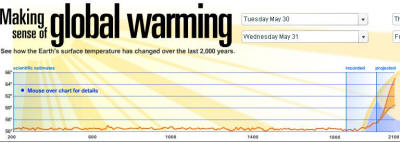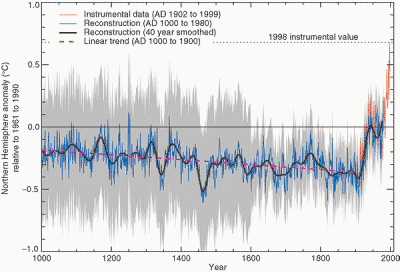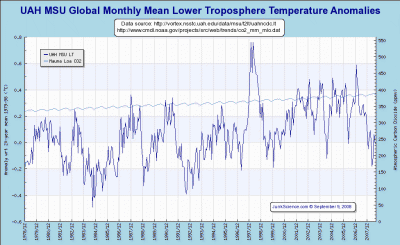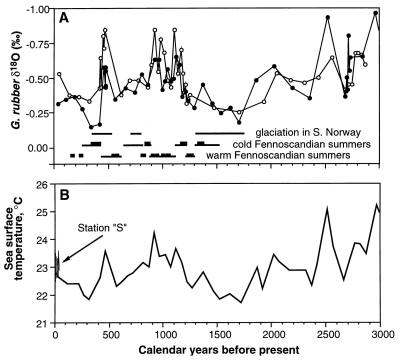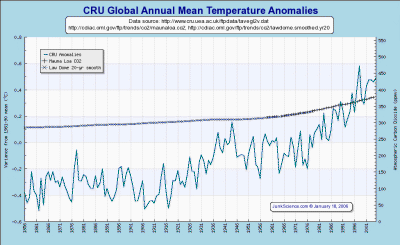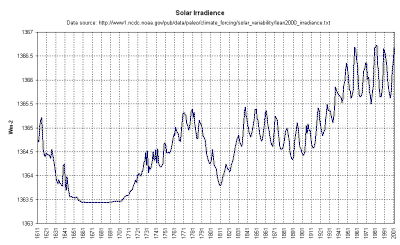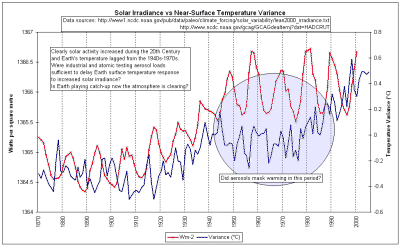|
from JunkScience Website
In response to apparent confusion regarding the Earth's greenhouse effect we recently released the real "Inconvenient Truth": greenhouse, global warming - and some facts, and this document assumes the reader to be comfortable with at least a rudimentary understanding of the topic.
In order to evaluate claims of global warming and enhanced greenhouse we need to examine estimates of global temperature and trends. As we gain an idea of the change involved we can attempt to quantify what portion of that change may be driven by other changes in the system.
Did human activity cause all, part or none of the observed change? Let's see what we can work out.
Topical in the news at present is USA Today's feature series, apparently meant to accompany Al Gore's movie and book circus, so we might as well start there.
The above
thumbnail links to a screen capture of their interactive global
temperature history and projection. The
capture was made from this
piece (from USA Today). We'll revisit this in a moment.
All apparently denied
such ability with the exception of Mike "Hockey Stick"
Mann, who
claimed a precision of 0.2 °C (0.36 °F). Those of us who spend much
time fossicking amongst raw data looking for clues to past
temperatures tend to greet such claims with an indulgent smile and
something like: "Sure Mikey, sure..." but that's his claim. This feature will be significant as we begin attempting to apportion possible causation later.
By now readers will be aware we are more than a little skeptical of claims of great precision reconstructing past temperatures, so perhaps we should take a moment to point out how imprecise are estimates even of current global mean temperature.
Of surprise to most people is that we don't even have an agreement on what we mean by absolute mean surface temperature. In addition to this lack of standardization is that there is a general paucity of data.
This may seem strange to people used to electronic media reports constantly telling us the temperature but, in truth, very little of the globe is regularly sampled for near-surface air temperature and such sampling is subject to local influences which change over time (see Lawrence Berkeley National Laboratory's Learning About Urban Heat Islands pages for more on this).
Near-surface measures are fraught with difficulties, not least is variation in sampling and drift over time in sampling location - see Microclimate Exposures Of Surface-Based Weather Stations: Implications For The Assessment of Long-Term Temperature Trends.
The late John L. Daly explored this problem in a report to the Greening Earth Society "The Surface Record - ‘Global Mean Temperature’ and how it is determined at surface level" which will tell you a lot more about the trials and tribulations of establishing temperatures.
The answer is yes, at least recently.
Since the late-1970s satellite-mounted
microwave sounding units (MSUs)
have provided data allowing the determination of tropospheric
temperatures and from this we are aware that there has been at least
some warming over the period. While it is apparent that much of the
trend is a result of the large El Niño-induced spike of 1998 there
is, however, reduced oscillation and some warming evident since
2000.
As we have seen above, according to the IPCC's TAR and America's picture paper, all warming has occurred since the Industrial Revolution. This belief has led to post hoc, ergo propter hoc claims of IR-driven warming (atmospheric carbon dioxide levels are known to rise, the planet is believed to warm, therefore atmospheric carbon dioxide warms the planet).
Actually there are lots of reasons, ranging from historical accounts
and literature to competing paleo-temperature studies, a number of
which are plotted for you here.
The Center for the Study of Carbon Dioxide and Global Change is currently engaged in their Medieval Warm Period Project, documenting,
We happen to find historical accounts and proxies indicating climatic variation rather more compelling than assertions of millennia-long climate stasis. Nonetheless we will work with such scenarios as we attempt some quantification of the drivers of global temperature change.
Regarding contemporary global mean temperature change, is it plausible, even likely, there has been a change of around a half-degree Centigrade since the Industrial Revolution? The short answer is "Yes".
The long answer is,
Is carbon dioxide the culprit? There has been an extraordinary amount written and said regarding the correlation between increasing atmospheric carbon dioxide levels since the Industrial Revolution and an apparent warming trend in global mean temperature.
From the
vehemence with which this is asserted one would assume the
temperature/atmospheric carbon dioxide plot to be absolutely
compelling. As can be seen in the graphic linked from the adjacent
thumbnail, such assumption is poorly founded.
It is probably no coincidence that that figure is almost precisely the same as that derived by plotting temperature forcing as determined by Professor Richard Lindzen (recall from our greenhouse page the plots of varied estimates of cooling in an atmosphere devoid of carbon dioxide). It also represents about three-fourths of the total anticipated warming from a doubling of atmospheric carbon dioxide because the temperature effect of increasing carbon dioxide is logarithmic.
This strongly suggests
that measurable global mean temperature increment from increasing
atmospheric carbon dioxide has almost run its course.
What about the sun? This Solar Irradiance Reconstruction is by Judith Lean, Naval Research Laboratory.
Back of an envelope calculation: Earth is estimated to have warmed 0.6 °C ± 0.2 °C so all we need to do is divide the estimated temperature increment by Earth's temperature (288 K) and times by 100 to get the percentage increment thus: 0.6 (K)/288 (K) x 100 = 0.2%. So, the sun is 0.2% more energetic and conveniently the planet's temperature is believed to have increased 0.2%.
Solar influence explains the entire change, now everyone's content the global warming thing has been solved, right? No? Us neither, although solar variance seems a likely candidate for at least a portion of the apparent change. Let's look at this a little more carefully.
Assuming all warming has taken place since the mid-Nineteenth Century, (an assertion with which we do not concur), solar influence could still account for the bulk of assumed change because the difference in solar irradiance from the (admittedly cherry-picked) low of 1889 to end of available record is 2.33 Wm-2 or 0.17% and Earth's temperature of 288 K + 0.17% = 288.49 K, a figure well within our warming bounds of 288.6 ± 0.2 K.
Superficially attractive and certainly the fit is significantly better than that observed for atmospheric carbon dioxide increment, although it is still less than perfect. Much has been made of sulphate aerosols "masking" warming that would otherwise have occurred and so we might ponder whether the post-WWII boom of reconstruction and development added significantly to atmospheric aerosols.
This could have induced
the apparent lag in solar warming in the 1950s and 1960s.
Additionally, this was the Cold War era of atomic weapons
development and atmospheric testing which could have added to
atmospheric particulate load (remember the fears of "nuclear
winter"?). Unfortunately, we lack the resources to check this at
present but we may revisit the hypothesis in the future. Further
research is required, as they say.
...to name but a few.
It could be that these other anthropogenic effects tend to
cancel each other out, leaving a net total change of zero, we just
do not yet know enough to quantify everything.
Estimated increased carbon dioxide forcing ~0.17 °C + percentage increase from increased solar irradiance ~0.49 °C = ~0.66 °C, well within the error bounds of +0.6 ± 0.2 °C.
We have seen nothing compelling regarding Earth's current
suspected temperature trend being anything extraordinary nor
alarming but we have no reason to believe Earth's mean temperature
is not changing, or that it does not do so continuously - frankly,
temperature stasis is a myth.
Note that Professor Pielke, Sr., is firmly in the camp of believers in anthropogenic global warming but freely admits carbon dioxide to be a less-than-critical factor necessitating obsession and, despite somewhat bizarre claims of Professor Lindzen being a "hired gun" and paid-for shill of an alleged "Big Oil" conspiracy, he is a senior and well-respected pure scientist who gleefully admits carbon dioxide's role in enhanced greenhouse, although he does point this out to be trivial and does not subscribe to the planetary emergency scenario.
Pielke and Lindzen are no orphans since most so-called
"skeptics" similarly point to anthropogenic climate influence as
interesting effects to be understood without necessitating
hand-wringing and hair shirts.
Absolutely and at least half of Earth's estimated mean temperature increment since the Nineteenth Century can be attributed to increased solar irradiance, probably more than four-fifths is from that source although we are still trying to sort out climate and forcings, something which will likely require decades yet.
Nonetheless, the best available thermometric temperature records list Earth's global mean temperature as variance from a commencing benchmark average, usually 1951-1980 or 1961-90, and show -0.3 °C c1880 or 1870, with 0.0 °C variance from this average occurring c1940 and with 2000 listed as +0.3 °C. In other words, Earth warmed 0.3 °C from origin of record to benchmark average by 1940, then warmed another 0.3 °C subsequently.
Since the
vast majority of the carbon dioxide increase in the atmosphere
occurred following the Second World War and this is concurrent with
only half the apparent temperature increase, the assumption is that
this increase was driven by some other cause, in this case the
increase in solar irradiance. There is no reason to believe all
other temperature varying forces ceased to exist when carbon dioxide
began accumulating, hence the "at least half" attribution above.
Although human emission
of carbon dioxide has likely had some measurable effect on planetary
temperature the effect from continued emission is rapidly
diminishing as radiative windows in which carbon dioxide is active
approach saturation. Before long carbon dioxide emission will have
exactly no discernable effect on global temperature.
If
there is to be a change in global mean temperature then warmer is
distinctly preferable to cooler.
Fortunately we are continuing to master our built environment while increasing productivity to leave more room and resources for wildlife and wild habitat, something only increased productivity can do in the face of increasing human population. Of course, increasing productivity relies both on abundant, affordable energy and abundant carbon dioxide.
There are
no apparent looming shortages of either, provided we don't do
anything stupid. Suddenly affecting lemming-like qualities and
following Ozone Al's teachings like a bunch of blind Patagonian
Sheep would qualify as something really stupid.
|

